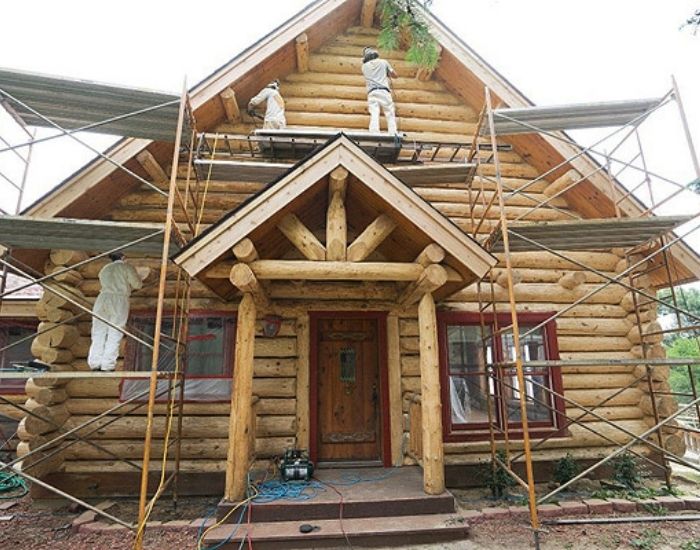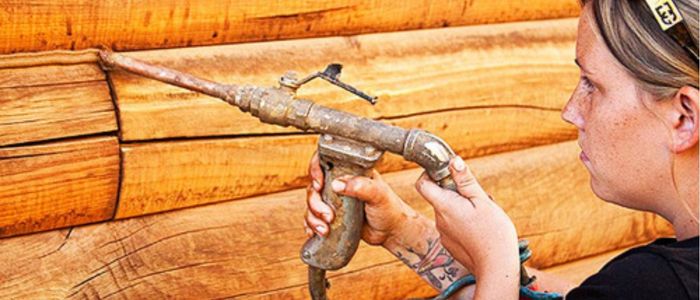
Protect Your Log Cabin. Restoration Tips for Fall
The mornings are colder now, frost laces the edges of your porch railing, and you started lighting fires not just for ambiance but for heat. At Sinrom Construction, we know just how important log cabin restoration services can be this time of the year.
Fall hits fast in the mountains, and if you own a log cabin in places like Bailey or Jefferson County, you already know: this season isn’t just pretty; it’s your final chance to get your home ready before winter barrels in. Here’s what you need to know to keep your log cabin standing against ice, snow, and whatever else Colorado’s winter throws at it.
Why Fall Maintenance Makes or Breaks Your Cabin
Picture this: it’s Halloween, and the first storm dumps a foot of snow. You meant to reseal the logs. You meant to patch that soft spot near the base. But now it’s too late; moisture’s in, temperatures are down, and repairs just got pricier.
That’s why log home maintenance in fall matters more than most people realize. This isn’t like prepping a vinyl-sided house in the city. Log homes breathe. They expand, contract, and soak up whatever you leave on the surface—including moisture, UV damage, and mildew.
At Sinrom Construction, we’ve rebuilt cabins that weren’t ready—and trust us, you don’t want to be the one learning that lesson after the first hard freeze.
Key Fall Maintenance Moves That Pay Off
Seal the Logs
This is your #1 defense. Old stain or failing sealant can let water creep into the grain, freeze, and split the wood. Our go-to advice? Address this now. Once temps drop low, you’ll be grateful you stained and sealed your log cabin.
Check for Rot
Look for soft, funky spots near the base or on exposed corners. If the wood gives when you press a screwdriver to it, it’s time to act, and you want to act fast. Wood rot prevention for log homes is not optional; it’s a key factor to keep your home standing for decades to come.
Gutter Cleanup
Pine needles, leaves, and early snow make a mess fast. If your gutters clog and overflow, your logs can stay wet longer, which isn’t good for anyone, particularly not your home.
Inspect Caulking and Chinking
Gaps? Cracks? Bugs finding their way in? You’re losing heat and risking moisture damage, or even worse, pests.
Check Your Roof
Fall’s the time to fix loose flashing, cracked shingles, or sagging spots. That ice dam won’t be polite about it in January, so you want to get to it while you can.
Signs It’s Time to Call the Pros
Some maintenance you can knock out on a weekend. But if you’re seeing the following, it’s time for professional log cabin repair:
- Discoloration or mold spots on your logs
- Soft wood around door frames or base logs
- Drafts from settling gaps or chinking failure
- Past fire or water damage that was never fully addressed
That’s where we step in. At Sinrom, we don’t just show up for surface fixes. We assess the full structure, identify weak points, and make sure you’re not dealing with the same issue next fall.
No disappearing crews. No vague timelines. Just honest work and mountain-tough solutions. We take seasonal care for log homes seriously. Period.
How We Winter-Proof Log Homes in the Mountains
Every cabin’s different. A remodel in Denver is one thing. A log home at 9,000 feet, where supplies come in on switchbacks and snow lingers till May? That’s where we shine.
Our log cabin restoration services start with a full exterior and interior walkthrough—checking everything from rooflines to floor joists. From there:
- We seal and stain with products that breathe and last.
- We repair rot with full log replacements or epoxy systems that hold through freeze-thaw.
- We upgrade chinking and insulation to keep heat in and pests out.
Think of it as preparing your log cabin for winter the right way. Not just slapping on a coat of stain and crossing your fingers.
Fall Is Short. Prep Smart.

You’ve got maybe six weeks left before winter comes for real. The difference between a cozy, problem-free season and a winter of stress? It’s what you do right now and what we at Sinrom Construction can do for your home.
If your cabin’s due for a check-up—or showing early signs of wear—don’t wait. Our log cabin restoration services are designed for Colorado homes like yours: built in the wild, tested by weather, and made to last.
Call us at 970.389.2501 or reach out online before the snow starts sticking.
FAQs
How do I know if my log cabin sealant is still doing its job?
Give the logs a close-up look, not from your truck window, but face-to-wood. If water beads up and rolls off, you're probably still in good shape. If it soaks in like a thirsty sponge? That’s your cue. Another test? Rub your hand along the grain. If the surface feels chalky, faded, or dusty, it’s time for new product. Most folks don’t realize this is one of the most basic yet crucial log cabin sealing tips — and ignoring it leads to bigger problems fast.
How can I tell if my logs are starting to rot before it gets serious?
Use a screwdriver and press gently into the wood near the foundation or under overhangs. If it sinks in more than a quarter inch or feels spongy, you’re looking at early-stage rot.
Is it too late to seal my cabin if nighttime temps are already dropping?
Depends how low they’re dropping. If it's dipping below 40°F at night, most sealants won’t cure right—they stay tacky or flake by spring. Your window for how to protect a log cabin in fall starts closing fast once mountain nights get cold. That’s why we always tell clients: don’t wait for snow in the forecast.
How long does a good stain or seal really last on a log home?
Three to five years is the general rule, but that’s if you’re using the right stuff and applying it right. High-altitude homes take a beating from UV, wind, and sudden freezes. South-facing walls wear down fastest.
How much moisture is too much when inspecting logs?
Here’s the truth: if your logs are staying damp for more than a day or two after rain or snowmelt, they’re not drying right, and that’s a problem. Moisture is a killer in log cabin restoration services—and the sooner we catch it, the less it costs to fix.
